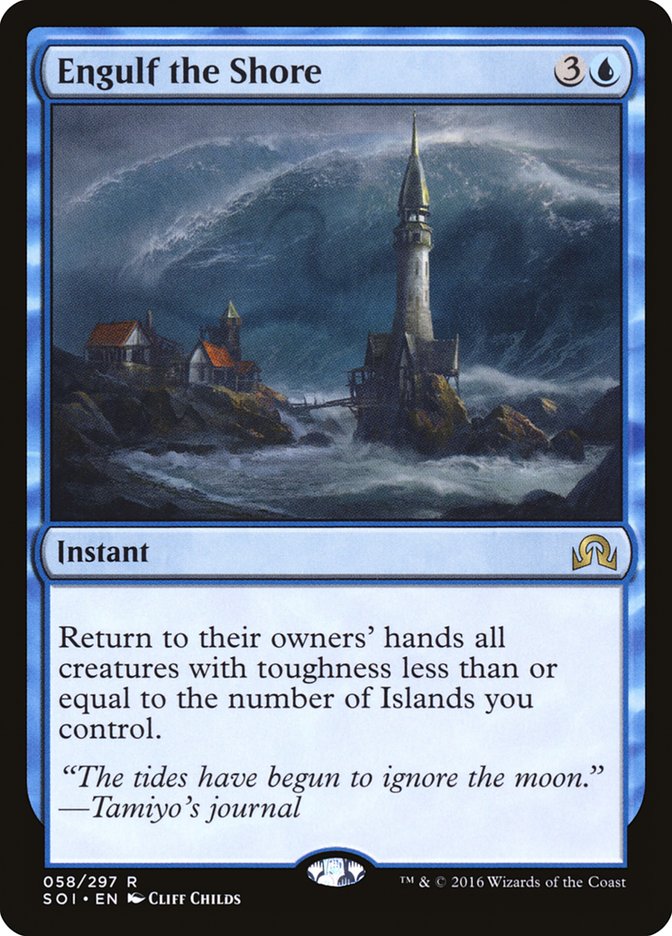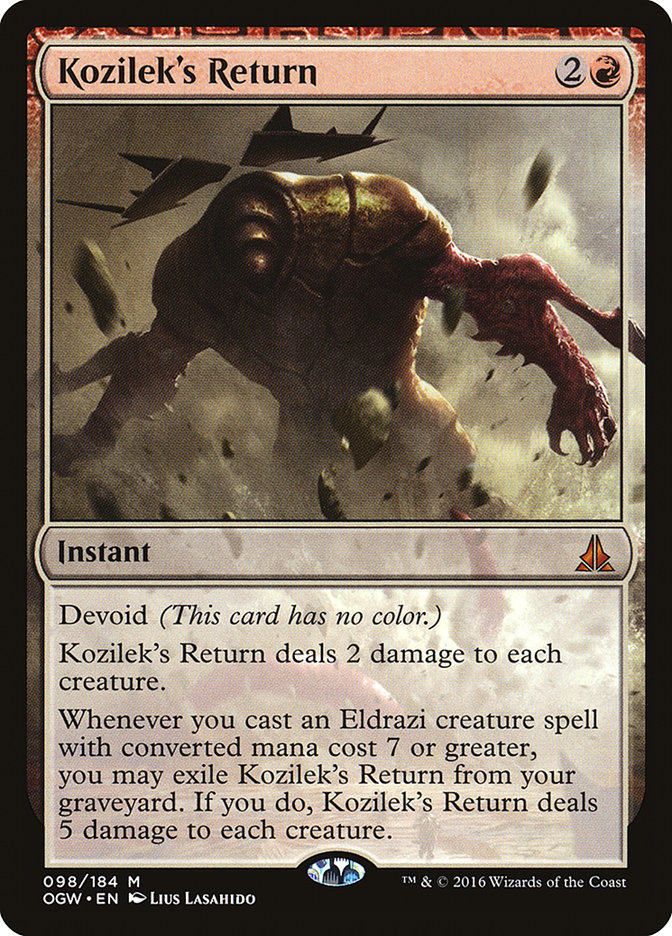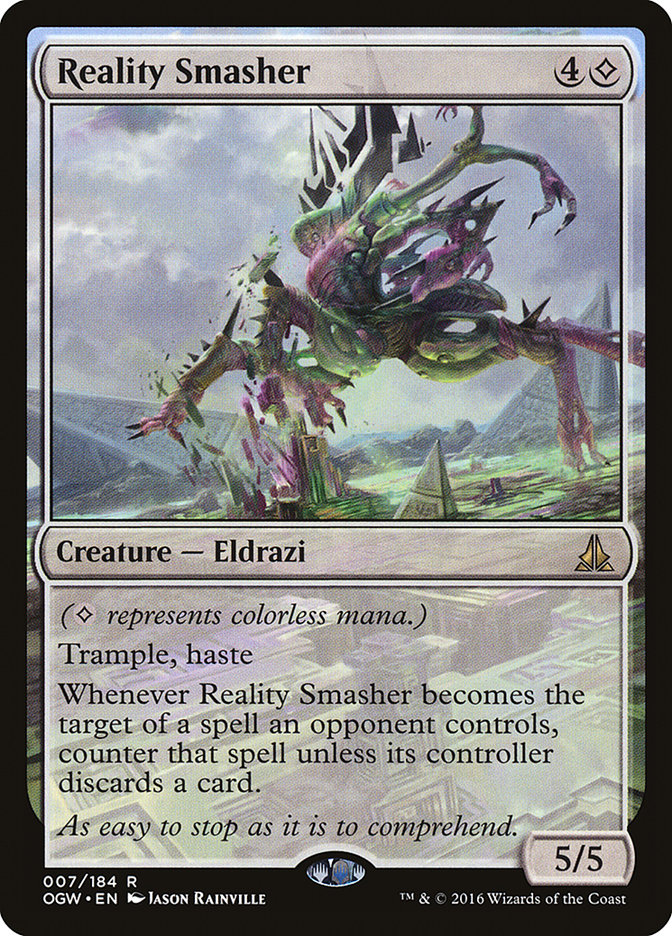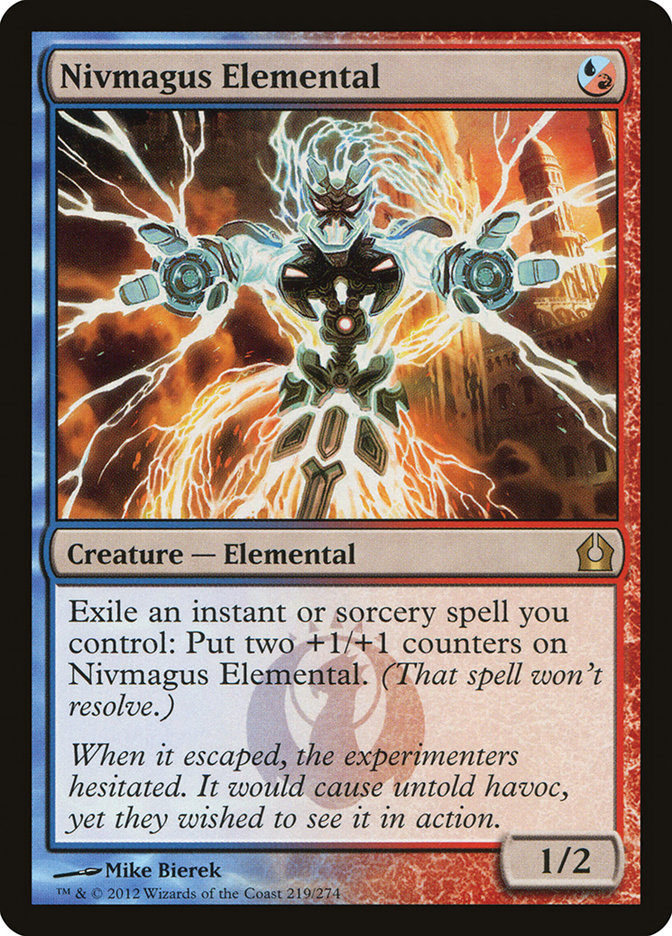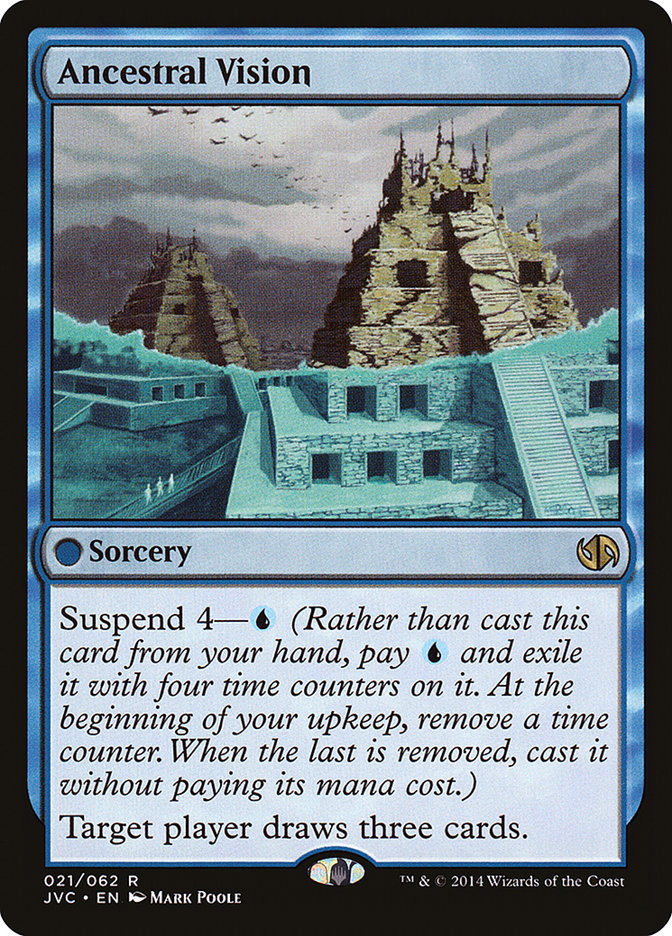I played Legacy for the first time in a while last weekend. The WMCQ and #SCGORL are great Standard tournaments to play in this weekend, plus I’ve been thinking a lot about Modern. Most of my articles are heavily focused on a specific topic, so today is where all the stuff that’s slipped through the cracks is going to be discussed.
Mostly, there’s going to be a lot of brews.
Standard
G/W Tokens is king. To the surprise of no one, I’m playing it this weekend at #SCGORL. That said, I still enjoy brewing.
Creatures (7)
Lands (28)
Spells (25)

Maybe Mono-Blue isn’t doable.
The main reason I want to try something other than U/R is because I was sick of having my lands enter the battlefield tapped. Kozilek’s Return, while nice, might not be worth the effort. Instead, I’m sticking with something a little closer to Adrian Sullivan’s Mono-Blue version with Engulf the Shore.
With Engulf the Shore over Kozilek’s Return, you’re typically buying time instead of actually dealing with their cards, which can be problematic. For example, in a world where your main way of removing a Reflector Mage is to bounce it, killing them with Ulamog, the Ceaseless Hunger is going to be difficult. That could certainly be one of those things that wouldn’t actually happen in-game, though. For example, you can bait out the Reflector Mage by casting Drowner of Hope, which they will need to remove. Maybe then you can Ulamog away their Reflector Mage, Engulf the rest of their creatures, and win from there.
Aside from that issue, I could see this deck being very good. If you’re playing against a black deck, you have a virtual bye. Against any slower green deck, it’s more of the same. Don’t let Gideon, Ally of Zendikar resolve and you should be in good shape against G/W Tokens.
W/R Humans is obviously difficult, but that’s only one matchup. The rest all seem close or favorable, with or without the red.
Modern
I’ll start by saying I’m supremely jealous of the people who have their single Modern deck that they love to play. Whenever a tournament is coming up, those people only have to adjust their deck slightly and they’re ready to battle.
For me, it’s always been a scramble to find a deck that I both want to play and is currently well-positioned. I’m starting to narrow things down, but at the same time, I feel like I have a lot of brewing to do. While decks like Jeskai Nahiri, Death’s Shadow Zoo, and Infect are on the short list, I still have hope that the format is breakable.
Creatures (27)
- 4 Ornithopter
- 3 Memnite
- 4 Signal Pest
- 4 Vault Skirge
- 4 Vile Aggregate
- 4 Reality Smasher
- 4 Thought-Knot Seer
Lands (19)
Spells (14)

While watching Niels Noorlander crush the #MTGOChamp, his friend Mitchell Manders and I were discussing a deck he played against in a Magic Online League (and that I had heard rumblings about) — Eldrazi Affinity. Before long, many of the other MOCS competitors were interested in the deck and a few were even battling in queues with it.
At first, the idea sounded great to me. Thought-Knot Seer and Reality Smasher are best when backed up by an aggressive curve, and with the loss of Eye of Ugin, Mox Opal and Springleaf Drum felt like they’d be the perfect replacements to help power out our fatties.
After watching some of the games, I think the deck has a ways to go. Vile Aggregate seemed like the weakest link. When facing removal, Vile Aggregate was never very big. However, it should be noted that Vile Aggregate, in addition to Thought-Knot Seer and Reality Smasher, were the reasons why the deck was performing so well against artifact hate.
There’s something here, but it needs some TLC.
Creatures (26)
- 4 Arcbound Ravager
- 3 Myr Enforcer
- 4 Ornithopter
- 4 Signal Pest
- 4 Vault Skirge
- 3 Bygone Bishop
- 4 Thraben Inspector
Lands (19)
Spells (15)

Bygone Bishop slows the deck down, since now you’re incentivized to hold your early creatures. Once Bygone Bishop is on the battlefield, your deck kind of goes off, including finishing the curve with a Myr Enforcer that should cost zero thanks to your Clue riches. For each Sanctum of Ugin you have, you can find another Myr Enforcer.
Perhaps this deck is trying to do too much. After all, you’d almost always prefer to be attacking with various Nexuses instead of cracking Clues in Affinity, but that just means your Cranial Platings and Arcbound Ravagers are very powerful.
Is this deck real? I have no idea.
Creatures (16)
Lands (17)
Spells (27)
- 4 Mishra's Bauble
- 4 Ground Rift
- 4 Mutagenic Growth
- 4 Gitaxian Probe
- 4 Gut Shot
- 2 Boros Charm
- 4 Temur Battle Rage
- 1 Gryff's Boon
Sideboard

Realistically, this is probably a bad Death’s Shadow Zoo deck.
Your mana is a tad better than the Death’s Shadow deck, but you’re forced into playing cards like Gut Shot and Ground Rift in your maindeck in order to facilitate Nivmagus Elemental. Gut Shot ranges from the best card in the format to wildly unplayable depending on what the metagame looks like, so it’s kinda risky.
Creatures (5)
Planeswalkers (5)
Lands (23)
Spells (27)

I’ve got some weird stuff going on here, but this is still one of my favorites for best Ancestral Vision deck in Modern.
This list is kind of updated, as I realize how to consolidate slots and focus on the bad matchups. I’m also trying some weird stuff like Jace Beleren and Cavern of Souls, which are either great or awful.
Lands (24)
Spells (36)

This is what I’m bringing with me in case I don’t make it to Day 2 of #SCGORL.
I may or may not splash for a copy of Time Sieve in the hopes that I can win the game quickly against various combo decks, but it probably won’t work.
At this point, the deck has gone through numerous iterations and I like where it’s at right now. Hopefully I don’t have to play Modern at #SCGORL, but it wouldn’t be the worst thing in the world.
Creatures (17)
- 2 Mistbind Clique
- 4 Spellstutter Sprite
- 3 Vendilion Clique
- 1 Snapcaster Mage
- 3 Eldrazi Displacer
- 4 Thought-Knot Seer
Lands (24)
Spells (19)
- 2 Mana Leak
- 4 Remand
- 3 Spell Snare
- 4 Ancestral Vision
- 4 Path to Exile
- 1 Sword of Feast and Famine
- 1 Declaration in Stone
Sideboard

At my Regional PTQ, I heard a great story (that may or may not be true) about a person getting his own Spellstutter Sprite Eldrazi Displacered in response to him casting a Bitterblossom. Naturally, his own spell got countered. His own Spellstutter Sprite put him in a soft lock!
While that’s a great play, it got me thinking about combining Eldrazi Displacer with Faeries. Historically, playing cards like Momentary Blink in your Faeries deck has gone horribly, as the white cards were typically worse than the black cards, but I’m just going to ignore that for now.
When I mentioned Ancestral Vision not being a safe unban, I always pictured a deck that was heavy on countermagic. Since Sword of the Meek was unbanned simultaneously and Nahiri, the Harbinger was also thrown into the mix around a similar time, I haven’t been incentivized to test those decks very much.
Creatures (4)
Lands (23)
Spells (33)
- 4 Lightning Bolt
- 2 Mana Leak
- 4 Serum Visions
- 2 Vedalken Shackles
- 2 Blood Moon
- 4 Remand
- 1 Electrolyze
- 4 Spell Snare
- 4 Ancestral Vision
- 1 Cryptic Command
- 1 Flame Slash
- 2 Harvest Pyre
- 2 Anger of the Gods
Sideboard

Unfortunately, counterspells are either great or terrible, depending on your matchup, which means this deck is probably not very good. Paul Rietzl’s version of Blue Moon is likely better for this specific metagame.
Realistically, if you’re going to use counterspells, you probably want them backing up some sort of clock.
Creatures (11)
Lands (24)
Spells (24)
- 4 Lightning Bolt
- 2 Mana Leak
- 4 Remand
- 4 Spell Snare
- 4 Ancestral Vision
- 2 Cryptic Command
- 2 Flame Slash
- 1 Sword of Feast and Famine
- 1 Vapor Snag
Sideboard

Faerie Miscreant isn’t out of the question either.
Not playing Serum Visions probably isn’t correct, but with Mutavault and the various Faeries, I don’t think you want the cantrip. Most of the time you are probably going to want to keep your mana open.
Sword of Feast and Famine is a card I like a lot and am definitely looking for a good place to utilize it. If you connect with it once, the game will likely spiral out of control from there, and Faeries is one of the best places for it.
Legacy
Another Grand Prix, another loss during a win-and-in. Sigh.
Creatures (11)
Planeswalkers (2)
Lands (20)
Spells (27)

I lost playing for Top 8 of Grand Prix Columbus with this deck, which is pretty good for not having played Legacy in months and basically building a deck from scratch. This Grixis Control deck is very similar to Noah Walker’s Grixis Delver deck, except with big card drawing spells instead of Delver of Secrets and more land and interaction instead of Daze.
While the Grixis Delver deck is good, I wanted something that could play a longer game against Miracles and the mirror match, so the Delvers had to go.
The deck obviously performed quite well, but I can’t recommend playing it. If I could do it all over again, I’d probably play a Sultai version of the same deck. All day long, I saw people with Lightning Bolts in hand with no answer to Tarmogoyf, which is part of the reason why Gurmag Angler was so good. Realistically, I didn’t need access to red mana, although I thought Young Pyromancer plus Gitaxian Probe plus Cabal Therapy would be very powerful against opponents playing combo. As it turns out, there weren’t many combo decks in the field, which makes sense, considering how prevalent Eldrazi was.
I wasn’t impressed by Young Pyromancer, Cabal Therapy, or the card drawing, but clearly something had to be performing well in order for me to make it so deep in the tournament. Rather than being able to point to one particularly thing that was good, I think the reason I did so well was because my deck was well-rounded and had a lot of play to it.
If my opponent stabilized, I had Deathrite Shaman and Lightning Bolt to burn them out, Young Pyromancer to go wide, or Jace, the Mind Sculptor to provide a wide array of difficult to deal with win conditions. If my opponents were presenting various threats, I had a bunch of different ways to answer them.
Despite them performing poorly, maybe I should have spent more time working on Thing in the Ice decks.
Creatures (24)
- 3 Thalia, Guardian of Thraben
- 2 Endless One
- 4 Eldrazi Mimic
- 4 Eldrazi Displacer
- 4 Reality Smasher
- 4 Thought-Knot Seer
- 3 Matter Reshaper
Lands (26)
Spells (10)

Michael Majors lost his last two rounds at Grand Prix Columbus to finish 11-4, and his deck was also spicy. I almost played it myself.
While I felt like playing Brainstorms, Majors was content putting all the tough decisions on his opponents while he focused on disrupting them and beating down. We took the Vintage shell and incorporated the things we liked, namely Eldrazi Displacer and Thalia, Guardian of Thraben. The options for white sideboard cards are excellent, including the underplayed Ravages of War (or Armageddon, but Ravages of War was actually easier for Majors to find).
The main concern is the lack of white mana sources and what you have to do to the explosive Eldrazi manabase in order to fit in white mana. Lands is an issue (specifically, Marit Lage is an issue), so cutting Wasteland is inexcusable. Some amount of City of Traitors and Eye of Ugis had to go in order to cast your white spells on time, which makes the deck less explosive and calls into question the usefulness of Eldrazi Mimic, Reality Smasher, and Endless One altogether.
Perhaps there’s a version of this deck that is lighter on the Eldrazi theme as a whole that ends up being better overall, but Majors was happy with his deck and his finish.
U/W Miracles
I don’t know about y’all, but I’m going to buy some Miracles cards.
Over the course of my Legacy career, I’ve done consistently well with very few archetypes, notably variations of Sultai and Counterbalance. Every other Legacy Top 8 has come thanks to a broken deck like Reanimator (with Mystical Tutor) or Survival of the Fittest. Yes, Eldrazi counts because no one was prepared for it.
While I tend to dabble in other archetypes, I never went back and revisited Counterbalance. I suppose that’s just the hipster in me. Now that I’m trying to tighten up my range and play better decks on average, picking up Miracles seems like the natural thing to do.
That said, I’m not sure when I’ll be playing Legacy again, so that can wait. Who knows? Maybe there will be something sweeter available by then.


